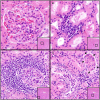Detection of CWD prions in urine and saliva of deer by transgenic mouse bioassay
- PMID: 19293928
- PMCID: PMC2654070
- DOI: 10.1371/journal.pone.0004848
Detection of CWD prions in urine and saliva of deer by transgenic mouse bioassay
Abstract
Chronic wasting disease (CWD) is a prion disease affecting captive and free-ranging cervids (e.g. deer, elk, and moose). The mechanisms of CWD transmission are poorly understood, though bodily fluids are thought to play an important role. Here we report the presence of infectious prions in the urine and saliva of deer with chronic wasting disease (CWD). Prion infectivity was detected by bioassay of concentrated, dialyzed urine and saliva in transgenic mice expressing the cervid PrP gene (Tg[CerPrP] mice). In addition, PrP(CWD) was detected in pooled and concentrated urine by protein misfolding cyclic amplification (PMCA). The concentration of abnormal prion protein in bodily fluids was very low, as indicated by: undetectable PrP(CWD) levels by traditional assays (western blot, ELISA) and prolonged incubation periods and incomplete TSE attack rates in inoculated Tg(CerPrP) mice (373(+/-)3 days in 2 of 9 urine-inoculated mice and 342(+/-)109 days in 8 of 9 saliva-inoculated mice). These findings help extend our understanding of CWD prion shedding and transmission and portend the detection of infectious prions in body fluids in other prion infections.
Conflict of interest statement
Figures




References
-
- Williams ES, Young S. Chronic wasting disease of captive mule deer: a spongiform encephalopathy. J Wildl Dis. 1980;16:89–98. - PubMed
-
- Williams ES, Young S. Spongiform encephalopathy of Rocky Mountain elk. J Wildl Dis. 1982;18:465–471. - PubMed
-
- Sigurdson CJ. A prion disease of cervids: chronic wasting disease. Vet Res. 2008;39:41. - PubMed
-
- Williams ES. Chronic wasting disease. Vet Pathol. 2005;42:530–549. - PubMed
Publication types
MeSH terms
Grants and funding
LinkOut - more resources
Full Text Sources
Other Literature Sources
Research Materials
Miscellaneous

